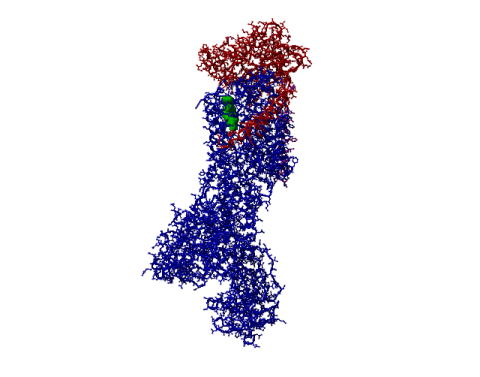Biodynamic and toxicokinetic modelling
Code: MED-BMS63, study points: 3, period: 2 / W40A, (October: Monday and Tuesday).


Coordinators:
Dr. R. Greupink, Department of Pharmacology and Toxicology, Radboud Institute of Molecular Life Sciences, rick.greupink@radboudumc.nl
Dr. T. Oostendorp, Dept. of Cognitive Neuroscience, Donders Institute for Neuroscience, t.oostendorp@donders.ru.nl
Code: MED-BMS63, study points: 3, period: 2 / W40A, (October: Monday and Tuesday).


Coordinators:
Dr. R. Greupink, Department of Pharmacology and Toxicology, Radboud Institute of Molecular Life Sciences, rick.greupink@radboudumc.nl
Dr. T. Oostendorp, Dept. of Cognitive Neuroscience, Donders Institute for Neuroscience, t.oostendorp@donders.ru.nl
Description
Toxicological and pharmacological actions of compounds on the body (their biodynamic effects) are closely related to the course of the plasma and tissue concentrations after exposure to a compound (its pharmaco- or toxicokinetics). In this course, you will explore state-of-the-art modelling and simulation approaches to describe and predict the kinetics of xenobiotics and their associated biological effects. In the course, you will become acquainted with techniques that allow you to capture kinetic and dynamic data from clinical studies in mathematical models, so that pharmacological and/or toxicological processes that are taking place in the body can be described adequately and be better understood (a so-called top-down approach). In addition, you will explore how in vitro pharmacokinetic and pharmacodynamic data of xenobiotics, e.g. gathered in overexpression systems, human cells and human tissues, can be used to predict the clinical disposition and biodynamic effects of such compounds. To this end, experimental laboratory data need to be combined with state-of-the art models of human physiology in order to extrapolate in vitro findings to in vivo consequences: a so-called bottom-up modelling approach. In the course, you will first be introduced to the various top-down and bottom-up modelling concepts via lectures, work groups and computer practicals. Next, these modelling concepts and approaches will be applied to help answer actual questions from ongoing research in Radboudumc research themes, resulting in an individually written research report that will be graded (see assessment section below).
Toxicological and pharmacological actions of compounds on the body (their biodynamic effects) are closely related to the course of the plasma and tissue concentrations after exposure to a compound (its pharmaco- or toxicokinetics). In this course, you will explore state-of-the-art modelling and simulation approaches to describe and predict the kinetics of xenobiotics and their associated biological effects. In the course, you will become acquainted with techniques that allow you to capture kinetic and dynamic data from clinical studies in mathematical models, so that pharmacological and/or toxicological processes that are taking place in the body can be described adequately and be better understood (a so-called top-down approach). In addition, you will explore how in vitro pharmacokinetic and pharmacodynamic data of xenobiotics, e.g. gathered in overexpression systems, human cells and human tissues, can be used to predict the clinical disposition and biodynamic effects of such compounds. To this end, experimental laboratory data need to be combined with state-of-the art models of human physiology in order to extrapolate in vitro findings to in vivo consequences: a so-called bottom-up modelling approach. In the course, you will first be introduced to the various top-down and bottom-up modelling concepts via lectures, work groups and computer practicals. Next, these modelling concepts and approaches will be applied to help answer actual questions from ongoing research in Radboudumc research themes, resulting in an individually written research report that will be graded (see assessment section below).
Main learning goals
After completion of the course, students are able to
1. Design a small clinical pharmacokinetic study with acetaminophen and learn how to derive relevant pharmaco- and toxicokinetic parameters from these data via non-compartmental and compartmental pharmacokinetic modelling approaches (top-down modelling approach).
2. Understand and apply physiology-based pharmacokinetic modeling (PBPK-modeling) approaches as a method to predict the clinical toxicokinetics of xenobiotics based on in vitro pharmacokinetic, biochemical and physico-chemical properties of xenobiotics (bottom-up modelling approach).
3. Predict the impact of variability in patient-specific factors and co-exposure to interacting drugs/xenobiotics on toxicokinetics.
4. Link the pharmaco-/toxicokinetics of xenobiotics to their desired and unwanted biodynamic effects using physiology-based or clinical PK/PD modelling approaches.
5. Understand how these modelling approaches are currently used in toxicological risk assessment, as well as in the research and development of new drugs.
After completion of the course, students are able to
1. Design a small clinical pharmacokinetic study with acetaminophen and learn how to derive relevant pharmaco- and toxicokinetic parameters from these data via non-compartmental and compartmental pharmacokinetic modelling approaches (top-down modelling approach).
2. Understand and apply physiology-based pharmacokinetic modeling (PBPK-modeling) approaches as a method to predict the clinical toxicokinetics of xenobiotics based on in vitro pharmacokinetic, biochemical and physico-chemical properties of xenobiotics (bottom-up modelling approach).
3. Predict the impact of variability in patient-specific factors and co-exposure to interacting drugs/xenobiotics on toxicokinetics.
4. Link the pharmaco-/toxicokinetics of xenobiotics to their desired and unwanted biodynamic effects using physiology-based or clinical PK/PD modelling approaches.
5. Understand how these modelling approaches are currently used in toxicological risk assessment, as well as in the research and development of new drugs.
